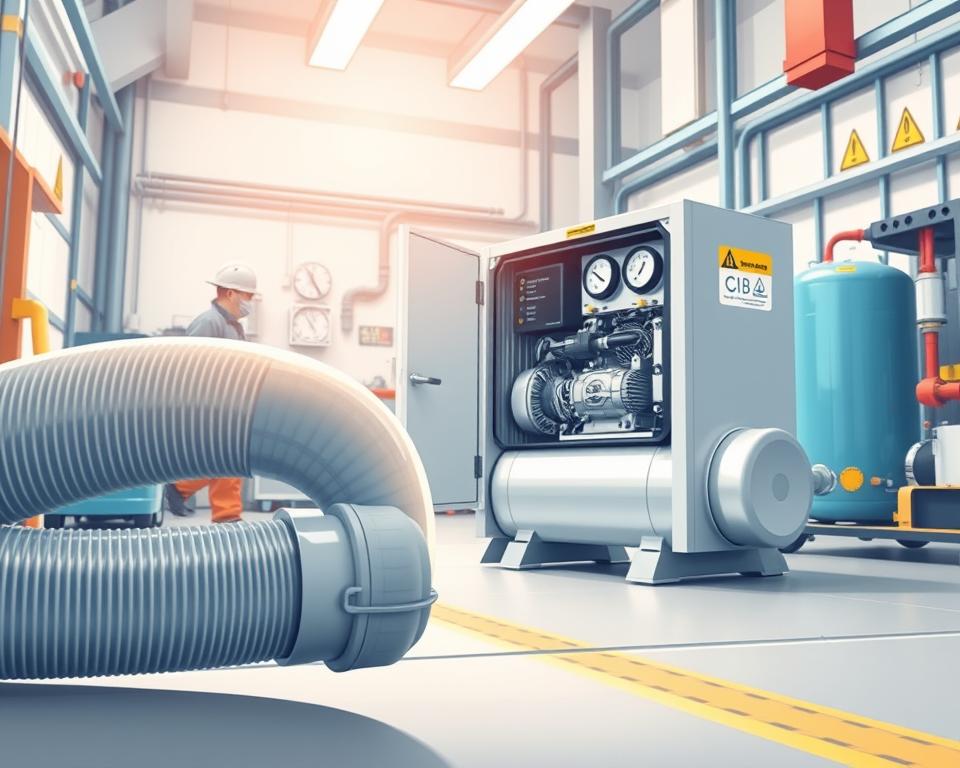Everything You Need to Know About PVC Air Compressor Piping
A burst compressed air line can discharge energy comparable to a stick of dynamite—did you know? Many facilities still use piping systems made from risky materials, unaware of the dangers. Here’s why you must prioritize safety over cost when selecting PVC air hose.
Although some plastics gain popularity, OSHA flatly forbids their above-ground application. Repeated contact with compressor oil and thermal cycling makes them brittle, causing explosive failures. Those so-called safe pressure limits don’t eliminate explosion risk.
Turn to Installation Parts Supply for sturdy aluminum systems. Spending on the right materials prevents OSHA penalties and protects employees. Here’s how to assemble a risk-free system.

Fundamental Learnings
- Explosion danger leads OSHA to outlaw some pipe materials.
- Heat and cold swings slashes claimed pressure capacity.
- Material becomes brittle with age, upping rupture chances.
- Switching to aluminum vastly improves safety.
- Invest wisely to dodge fines and protect staff.
Why PVC Pipe Is Dangerous for Compressed Air Systems
PVC makers caution never to employ it in high-pressure air setups. Compressed air carries destructive energy; a burst is like a dynamite blast. Select your piping wisely to avoid deadly failures.
- Brittleness: Below-freezing conditions render PVC dangerously brittle.
- Adhesive failures: Oil contamination and heat cycles break down glue bonds.
- Misleading ratings: Ratings halve by 110°F, a common shop temperature.
OSHA cites a $110,000 fine after a facility’s piping shattered, injuring workers. Don’t forget, compression heat cuts into rated safety margins.
“Above-ground use of certain plastics for compressed air violates OSHA standards due to explosion risks.”
Metal alternatives fail more predictably, bending rather than fragmenting. PVC shards fly far and fast, causing collateral damage.
Daily heat and cold cycles in a workshop degrade plastics rapidly. A decade’s UV and chemical attack weakens plastic, so small leaks too often balloon into disasters.
Recommended Piping Materials for Compressed Air
Aluminum air lines deliver superior safety and leak reduction. They leak 90% less than black iron, making them ideal for today’s shops. Lightweight, rust-proof aluminum stands up to years of service.
Threadless modular aluminum assemblies speed assembly. Installation Parts Supply stocks ready-to-snap aluminum modules. A Midwest auto plant cut labor costs by 40% after switching to this system.
- Copper: Ideal in sterile environments for its germ-killing copper surface. Requires soldering expertise.
- Stainless Steel: Resists rust in humid areas like coastal workshops.
- ABS/HDPE: Chemical-resistant for labs and factories handling solvents.
“Our aluminum retrofit reduced energy waste by 15%—paying for itself in 18 months.”
Don’t ignore torque specs. Too tight splits fittings; too loose lets air escape. Aluminum fittings generally torque to 25–30 ft-lbs—follow the guide.
Use NSF-certified materials when air quality is critical. Choose pipe rated for your specific operating environment.
Selecting the Best Air Compressor Piping
Consider cost, compliance, and efficiency in your pipe decision. One plant slashed $12k per year by adopting aluminum lines. Use this guide to select the optimal material.
| Material | Cost (per ft) | Maintenance | ROI Time |
|---|---|---|---|
| Aluminum | $8.50 | Low | 18 months |
| Black Pipe | $5.00 | High | N/A |
| Copper | $10.20 | Medium | 24 months |
Don’t ignore thermal limits. From arctic chills to high heat, aluminum outperforms. Stainless steel stands up to harsh chemicals.
Pro Tip: Compute ROI based on compressed-air leakage. Don’t let 10% leakage cost you $3,500 a year.
- Match PSI ratings to your compressor’s output.
- Verify your system meets OSHA welding and pressure-test rules.
- Get a complimentary piping audit from Installation Parts Supply.
“Our aluminum retrofit cut energy waste by 15%—paying for itself in 18 months.”
DIY installations work for small shops, but professionals ensure leak-free joints. Don’t forget to read the fine print on warranty lengths.
In Closing
Safety outweighs sticker price in compressed-air piping. Ninety-two percent of pipe failures occur in aging lines, frequently causing injuries. Aluminum offers 99.8% reliability, making it a smart long-term choice.
Don’t forget:
- Avoid brittle materials that shatter under pressure.
- Metallic lines beat plastics on both safety and durability.
- Failing to comply can cost you big in fines and claims.
Ready to upgrade? Grab same-day pricing and deals on kits from Installation Parts Supply. Access a complimentary maintenance template or request urgent replacements.
Invest in secure lines now to protect your crew.
